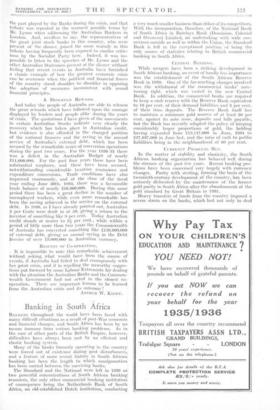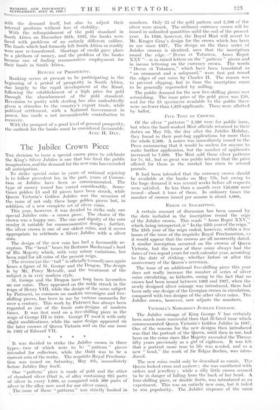Banking , in South Africa
BANKERS throughout the world have been faced with many difficult situations as a result of post-War economic and financial changes, and South Africa has been by no means immune from serious banking problems. As in the case of other, parts of the British Empire, however; difficulties have always been, met .by an efficient and elastic banking system. Many of the banks formerly operating in the country were forced out of existence during past disturbances4 and a feature of more recent history, in South African banking has been the length to which amalgamation, has been carried between the surviving banks.
• The Standard and the National were left in 1920 as two powerful concentrations of South African banking resources, the only other commercial banking institution of consequence being the Netherlands. Bank of South Africa, an old-established. Dutch institution; conducting a very much smaller business than either of its competitors: With the incorporation, therefore, of the National Bank of South Africa in Barclays Bank (Dominion, Colonial and Overseas). Lithited, -an undertaking with wide con- nexions outside as well as within the Union, the Standard Bank is left in the exceptional position of being the only source of statistics relating to British commercial banking in. South Africa.
CENTRAL BANKING.
While mergers have been a striking development in South African banking, an event of hardly less importance was the establishment of the South African Reserve Bank in 1920. One of the far-reaching changes involved was the withdrawal of the commercial banks' note,. issuing right, which was vested in the new Central Bank. In addition, the commercial banks are required to keep a cash reserve with the Reserve Bank equivalent to 10 per cent, of their demand liabilities and 3 per cent. of their time deposits. The Reserve Bank itself has to maintain a minimum gold reserve of at least 80 per cent. against its note issue, deposits and bills payable, but the Bank has recently adopted the policy of keeping considerably larger proportions of gold, the holding having expanded from £19,117,000 in June, 1984 to £27,887,000 in June last, and the ratio of cash to public liabilities being in the neighbourhood of 60 per cent.
CURRENCY PROBLEMS MET.
In the matter of stability and elasticity, the South' African banking organization has behaved well during the stresses -of the past few years. Recent banking pro- blems have been concerned very largely with currency changes. Parity with sterling, forming the basis of the twentieth-century development of the country, has been seriously dislocated by the maintenance of. the former gold parity in South Africa after the abandonment of the gold standard by Great Britain in 1931.
Heavy transfers of funds from the country imposed a severe strain on the banks, which had not only tn deal With the demand itself, but also to adjust their internal positions without loss of stability. With the relinquishment of the gold standard in South Africa on December 28th, 1982, the banks were faced with problems of an entirely different calibre. The funds which had formerly left South Africa so readily Were now re-transferred. Shortage of credit gave place to a plethora of money, and the problem of the banks became one of finding remunerative employment for their funds in South Africa.
RETURN OF PROSPERITY.
Banking seems at present to be participating in the beginning of a period of prosperity in South Africa, due largely to the rapid development of the Rand, following the establishment of a high price for gold through the abandonment of the gold standard. Reversion to parity with sterling has also undoubtedly given a stimulus to the country's export trade, while political settlement, with a National Government in power, has made a not inconsiderable contribution to recovery. With the prospect of a good level of general prosperity, the outlook for the banks must be ,considered favourable.
ALEC H. DAY.



























































 Previous page
Previous page